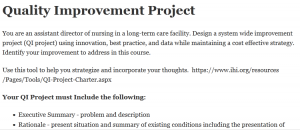Quality Improvement Project

You are an assistant director of nursing in a long-term care facility. Design a system wide improvement project (QI project) using innovation, best practice, and data while maintaining a cost effective strategy. Identify your improvement to address in this course.
Use this tool to help you strategize and incorporate your thoughts. https://www.ihi.org/resources/Pages/Tools/QI-Project-Charter.aspx
Your QI Project must Include the following:
- Executive Summary – problem and description
- Rationale – present situation and summary of existing conditions including the presentation of potential options
- Expected outcome and benefits – include the financial details (budget plan)
- AIM statement (fully developed with SMART objectives)
- Outcome measures – including the metric, organizational definitions and collection source (may want to use a graph)
- Activities and barriers – including implementation plan, timeline and schedule
Rubic for grading:
1. Explanation of Issues: Issue/problem to be considered critically is stated clearly and described comprehensively, delivering all relevant information necessary for full understanding. (20%)
2. Evidence – Selecting and using information to investigate a point of view or conclusions: Information is taken from source(s) with enough interpretation/evaluation to develop a comprehensive analysis or synthesis. Viewpoints of experts are questioned thoroughly. (20%)
3. Influence of context and assumptions: Thoroughly (systematically and methodically) analyzes own and others’ assumptions and carefully evaluates the relevance of contexts when presenting a position. (20%)
4. Student’s position (perspective, thesis/hypothesis: Specific position (perspective, thesis/hypothesis) is imaginative, taking into account the complexities of an issue. Limits of position (perspective, thesis/hypothesis) are acknowledged. Others’ points of view are synthesized within position (perspective, thesis/hypothesis). (20%)
5. Conclusions and related outcomes (implications and consequences): Conclusions and related outcomes (consequences and implications) are logical and reflect student’s informed evaluation and ability to place evidence and perspectives discussed in priority order. (20%)